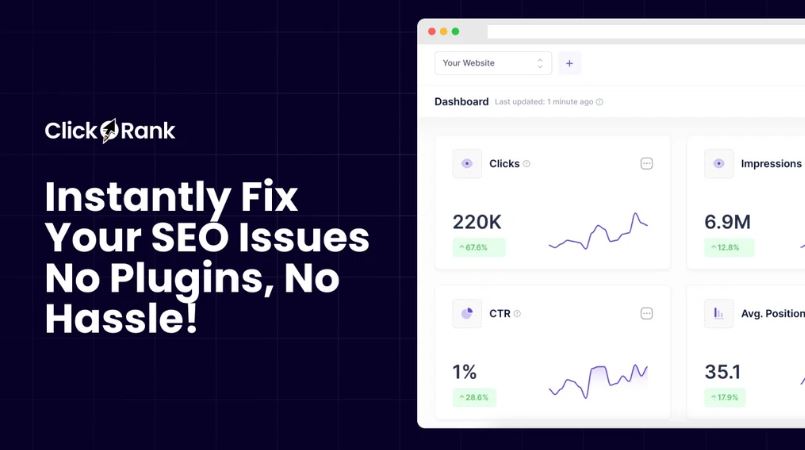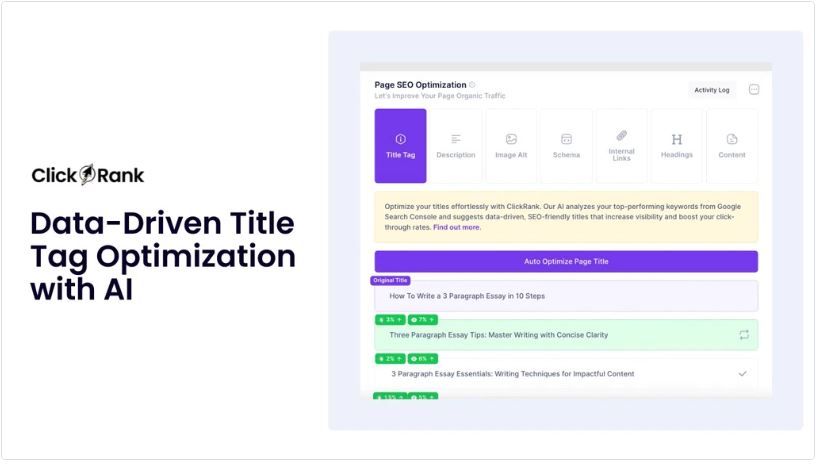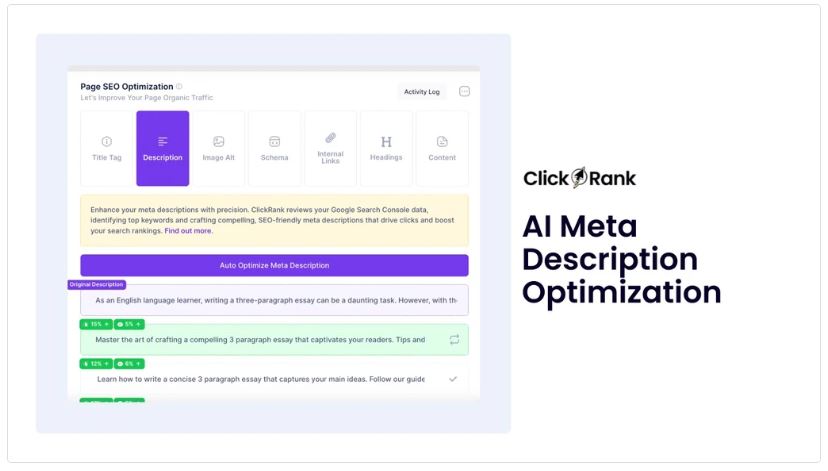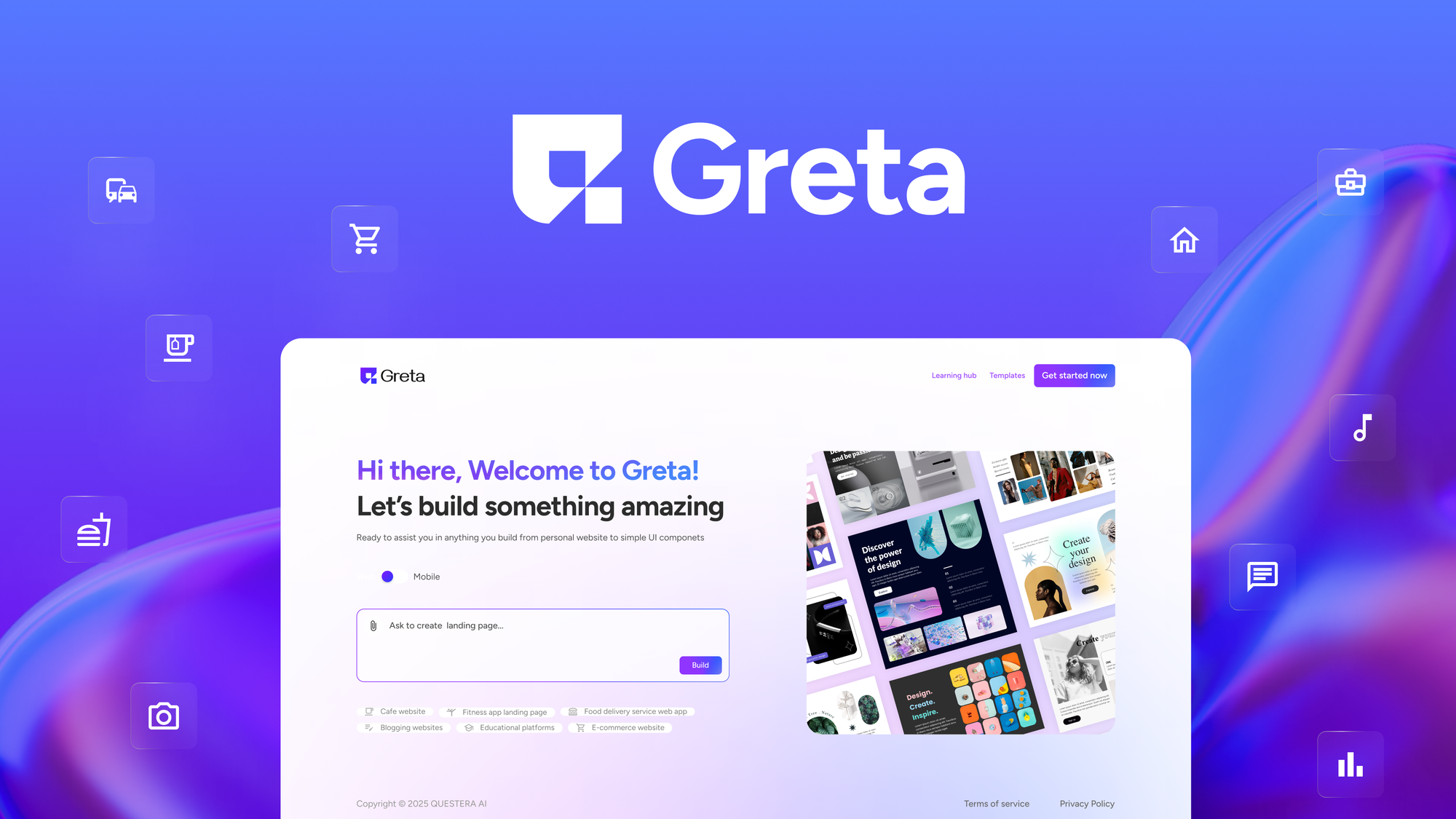You know that moment when you think you’ve seen it all in SEO—and then, along comes something like ClickRank? I was skeptical at first (another AI tool, right?), but after wrangling with dashboards, botched automations, and a sea of empty promises from endless SaaS tools, ClickRank actually made me sit up. So here’s the story of how I followed the breadcrumbs of real-time metrics, auto-fixes, and smart suggestions—sometimes getting sidetracked by unexpected features—and ended up with a site that actually worked better, not just on paper, but on the SERPs. Oh, and I found an actual use for schema markup that doesn’t make my head spin.
Table of Contents
ToggleWhen SEO Gets Personal: My ClickRank Setup Adventure
I’ll be honest—most SEO tools make me feel like I need a PhD just to get started. But my ClickRank AI SEO Optimization journey? It was refreshingly different. The whole process kicked off with something I usually dread: connecting my Google Search Console. But here’s the twist—ClickRank’s Google Search Console integration was so smooth, I almost didn’t believe it was done. A couple of clicks, a quick copy-paste of their JavaScript snippet onto my site (yes, I triple-checked my code out of habit), and that was it. No endless forms, no waiting for verification emails, no arcane setup rituals.
From the moment I landed on the dashboard, it was clear this wasn’t just another generic analytics tool. The SEO performance metrics dashboard didn’t bombard me with jargon or graphs I’d never use. Instead, I got real-time SEO metrics that actually made sense: clicks, impressions, and my average search position, all broken down by country. It’s the kind of data you want to see when you’re trying to make real decisions, not just pat yourself on the back for a traffic spike last month.
What really stood out was how immediate everything felt. Research shows that tracking real-time metrics like clicks and impressions helps users act fast and spot SEO wins or woes early. With ClickRank, I wasn’t left waiting for stats to update next week. The dashboard refreshed with live data, making SEO feel less like a guessing game and more like a living, breathing process. I could literally see the impact of changes as they happened, which is a game-changer for anyone who’s tired of flying blind.
Let’s talk about the personal side for a second. I’ve always wondered which keywords were quietly tanking my traffic. Thanks to ClickRank’s deep-dive into real search data, I finally saw the cold, hard truth—turns out, “Toronto waterproofing” was dragging my numbers down. It was a little humbling, but also empowering. I could finally take action instead of just speculating.
ClickRank’s integration with Google Search Console isn’t just a technical feature—it’s a real differentiator. It gives instant access to the kind of data that makes setup meaningful from the very start. And the metrics dashboard? It feels tailored, not just a one-size-fits-all solution. I found myself actually enjoying the process of exploring my site’s performance, which is not something I ever expected to say about SEO tools.
ClickRank takes the mystery out of your site’s performance—it’s like putting on glasses when you didn’t realize you were nearsighted.
From setup to first login, ClickRank turns the typical “SEO tool onboarding” headaches into a two-step process. Suddenly, you’re looking at a dashboard showing live data that actually means something for day-to-day decisions. It’s not just about seeing numbers—it’s about understanding what they mean for your site, right now.

Smart Automation Meets Human Oversight: Audits, Auto-Fixes, and Unlikely Surprises
When I first ran ClickRank’s site audit, I expected the usual vague warnings and generic advice. Instead, I got a wake-up call: apparently, my title tags were marathon runners—way too long for Google’s liking. The ClickRank site audit features didn’t just flag obvious errors; they uncovered technical SEO issues I’d never even considered. Suddenly, those abstract warnings from other SEO tools felt like a distant memory. Here, every issue was visual, tangible, and—best of all—actionable.
What really set ClickRank apart for me was the SEO automation tools built right into the audit dashboard. I spotted a cluster of duplicate H1 tags and a handful of meta descriptions that were either missing or just plain uninspired. Normally, this would mean a tedious slog through my CMS, hunting down each page. But with ClickRank’s auto-solve feature, I fixed multiple problems in a single click. I thought I’d miss micromanaging every detail, but… I didn’t. In fact, I found it oddly satisfying to watch ClickRank clean up my meta mess with such efficiency.
One-click solutions shouldn’t feel this rewarding, but watching ClickRank clean up my meta mess felt oddly satisfying.
The Technical SEO functions don’t stop at titles and meta tags. ClickRank’s automation also tackles duplicate H1s and even suggests improvements for on-page content. Research shows that AI-powered auto-solves like these reduce dependency on developers and manual labor, freeing up time for more strategic work. And because the audit is so visual, it’s easy to see exactly where your site stands—and what needs fixing.
But here’s where things got unexpectedly interesting: schema markup and internal linking. I’ll admit, I’ve always found schema markup generation daunting—dusty, technical, and easy to mess up. ClickRank changed that. With Automatic Schema Markup Generation, the tool auto-generates schema based on real page data. No guesswork, no code. Suddenly, my pages were more indexable and eligible for rich snippets, and I didn’t have to lift a finger. Studies indicate that automated schema like this genuinely improves how search engines understand and display your content.
Then there’s the ClickRank internal linking algorithm. I took a wild detour exploring the Smart Internal Links Generation feature, and honestly, I never expected AI suggestions to feel this practical. With a single click, ClickRank analyzed my site’s structure and content, then generated contextually aware internal links—complete with optimized anchor text. This didn’t just boost my SEO health; it made user navigation smoother and kept visitors engaged longer.
-
Automation: Title tag and meta description fixes, duplicate H1 elimination
-
Schema markup: Auto-generated based on page data
-
Internal linking: AI-generated, contextually aware
What I love most is how audits become action plans, not just warnings. Internal links get smarter (and automatic). Schema markup, usually intimidating, starts to make sense—even for the non-tech crowd. ClickRank’s blend of smart automation and human oversight is a game changer for anyone serious about SEO.

Putting SEO on Autopilot—But Staying in the Driver’s Seat: Reporting, Optimization, and Why I’ll Never Ignore CTR Again
If you’ve ever felt lost in a sea of SEO data, you’re not alone. I’ve been there—staring at endless numbers, wondering which page or keyword to tackle next. That’s where ClickRank’s SEO insights reporting changed everything for me. Instead of guessing, I finally had custom reports that spelled out exactly which pages and queries needed attention. No more shooting in the dark; it was like having a roadmap to my next SEO win.
The reporting feature is, honestly, a game-changer. With just a few clicks, I could generate detailed reports by time period, sort pages or queries by clicks or impressions, and instantly see which keywords were driving traffic—or falling flat. The keyword optimization analysis didn’t just show vanity metrics; it highlighted real opportunities. I could see, for example, how “waterproofing Toronto” performed across multiple pages, complete with clicks, impressions, and whether those keywords were optimized in titles, meta descriptions, or content. It’s the kind of actionable insight I’d always wanted but never found in other tools.
But here’s where it gets even better: Auto Content Optimization. I used to dread content optimization. The old approach felt like a balancing act between keyword stuffing and keeping things readable. With ClickRank, that’s ancient history. Their AI-powered Content optimization with ClickRank injects high-performing keywords from real Google Search Console data—without making my content sound robotic. I just hit the auto content SEO optimization button, and suddenly my pages were more relevant and visible, all while sounding natural and on-brand. No code, no hassle.
And let’s talk about improving click-through rates (CTR). I used to overlook CTR, focusing more on rankings and traffic. Big mistake. ClickRank’s reports made it painfully clear how much I was leaving on the table. By tracking CTR, keyword positions, and letting the AI nudge me toward smart tweaks, I saw visible improvements within weeks. Engagement metrics like CTR aren’t just numbers—they’re gold. They directly connect my optimization actions to real results, and I’ll never ignore them again.
-
Key performance indicators like CTR, clicks, impressions, and keyword positions per page are all right there—no digging required.
-
Auto Content Optimization covers keyword injection, schema tagging, and meta updates, all in one place.
-
Reports break down data per page and per query, so I always know where to focus my efforts.
ClickRank’s reporting doesn’t just show you what you want to see—it tells you what you need to fix, right now.
Honestly, seeing reports and insights move from academic to actionable felt like winning a string of small SEO lotteries. Research shows that auto content optimization and reporting features help users quickly identify areas for improvement, boosting both rankings and engagement. CTR and keyword-based reporting prioritize real results over vanity metrics, and I could feel that difference in my own results. It’s not just about data—it’s about knowing exactly what to do next, and seeing the payoff almost immediately.

Is ClickRank Actually Worth It? The (Only Slightly Tangential) Verdict
Let’s get straight to the point: after weeks of testing, poking, and prodding, I can honestly say ClickRank is more than just another SEO Automation Tool. It’s the kind of AI-powered SEO tool that quietly works in the background, chipping away at those nagging technical issues and on-page optimizations that used to eat up my evenings. And when you look at ClickRank pricing and features, especially with the lifetime deal on the table, it’s hard not to see the value stacking up.
At $69/month, ClickRank is priced to be accessible. Not just for agencies with deep pockets, but for solo operators and small businesses who need real SEO uplift without the overhead. The lifetime deal (which, let’s be honest, is a unicorn in the all-in-one SEO platform world) makes it even more tempting. I grabbed it through this affiliate link and haven’t looked back. For me, the automation and peace of mind alone felt like a fair swap for the price.
But here’s what really surprised me: ClickRank’s flexibility. It supports my go-to CMS platforms—WordPress and Shopify—right out of the box. That means I can jump in or out without feeling locked into a system. If you’re running a custom solution, there’s support for that too. This accessibility across platforms keeps ClickRank future-proof, and honestly, it’s a relief to know I’m not painting myself into a corner.
Now, let’s talk about the features that actually move the needle. ClickRank isn’t just about pretty dashboards (though, yes, the reports are slick). It automates the nitty-gritty: title tags, meta descriptions, image alt text, header optimization, and even schema markup. Research shows that automating these on-page SEO tasks can significantly boost click-through rates and search rankings. The tool’s direct integration with Google Search Console means it’s not guessing—it’s working with real query data to drive targeted improvements.
The internal linking system is another standout. Using AI, ClickRank suggests and implements contextual internal links with optimized anchor text. This isn’t just a time-saver; it’s a strategic advantage. Add in the Auto Content Optimization system, which injects high-performing keywords from your top search queries, and you’ve got a platform that actually understands what your content needs to rank.
And the best part? I’m not stuck cobbling together a bunch of different tools. ClickRank’s all-in-one approach saves me money and, more importantly, saves me from the headache of managing multiple subscriptions and logins. For small players like me, that’s a game-changer.
Calling ClickRank ‘just another SEO tool’ is like calling a Swiss Army knife ‘just a pocketknife’—it does more than you expect, and the value adds up.
So, is ClickRank worth it? For me, the answer is a clear yes. The surprise wasn’t just in the slick reports or quick fixes—it’s in the way ClickRank reduces my SEO headaches day after day, even on a budget. If you’ve ever felt haunted by persistent SEO issues, this tool is almost therapeutic. And with flexible pricing plans, you can choose the option that best suits your needs. Ready to optimize your website? Sign up now and unlock the power of ClickRank.
TL;DR: ClickRank isn’t just another SEO tool—its blend of real-time data, clever automations, and human-friendly controls helped me boost rankings, fix issues fast, and save hours a week. If you want a smarter, less stressful SEO approach, this platform just might surprise you. Don’t forget: snag the lifetime deal here.





